Some like the VAT because it offers a new way to finance bigger government. Others like the VAT because—at least compared to the income tax—it does not impose as much damage on the economy. Some want to use the revenues from a VAT to facilitate tax reform and/or Social Security reform. There are even some people who believe that a VAT will somehow reduce the trade deficit.
However, many people dislike the VAT, often for some of the reasons listed above. Supporters of limited government oppose the tax because it makes it easier for politicians to expand the size of government. By contrast, some on the left oppose the VAT because of its one redeeming feature—it is a consumption-based levy and therefore not as easy to use for economically destructive income redistribution.
Although it is a relatively non-destructive way to collect revenue, a VAT would be a serious mistake for the United States. The only condition that would make a VAT acceptable is complete repeal of all income taxes and a constitutional amendment that prohibits Congress from re-imposing taxes on any type of income. But this is not a realistic option, which is why the VAT should be stopped.
If history is any guide, a VAT will have several adverse effects. Specifically, a VAT will:
- Expand the cost of government. Countries with VATs have a much heavier total tax burden than those without VATs. Before the creation of VATs, the burden of taxation in Europe was not that much larger than it was in the United States. However, since the late 1960s, when countries in Europe began to adopt VATs, Europe’s aggregate tax burden has increased by about 50 percent while the U.S. tax burden has remained relatively constant.
- Inadvertently increase income tax rates. One of the main arguments for the VAT is that it is a less destructive way to raise revenue. This is theoretically true, but irrelevant. In the real world, the VAT has been used as an excuse to increase income taxes as a way to maintain “distributional neutrality.” Indeed, income taxes in Europe today are higher than they were when VATs were implemented.
- Slow economic growth and destroy jobs. A VAT undermines economic growth for two reasons. First, it reduces incentives to engage in productive behavior by driving a larger wedge between pre-tax income and post-tax consumption. Second, it facilitates larger government and the concomitant transfer of resources from the productive sector of the economy to the public sector, diminishing economic efficiency.
A VAT almost certainly is a no-win proposition for America. Theoretically, a VAT would be acceptable if it were combined with ratification of a constitutional amendment that permanently prohibits both the personal and corporate income taxes, but this is an extremely unlikely scenario. It is far more likely that a VAT would be implemented in addition to the income tax—which is precisely why it is such a bad idea.
What Is a VAT?
A VAT is levied on the “value added” to goods and services as they pass through each stage of the production process. There are two ways to impose a VAT, and both require businesses of all types to serve as tax collectors. The most common form, the credit-invoice VAT, operates somewhat like a sales tax. As explained by the Congressional Budget Office:
[The credit-invoice VAT] is typically administered by taxing the total value of sales of all businesses, but allowing businesses to claim a credit for taxes paid on their purchases of raw materials, intermediate materials, and capital goods from other businesses.[1]
By imposing a tax on receipts but then allowing a credit for VAT taxes collected at earlier stages of production, the credit-invoice VAT taxes the “value added” by each business. The total tax, regardless of the stage of production at which it was collected, ends up being added to the final sales price.
No matter how many steps there are in the production process, a fixed percent of the final price of the product would represent the value-added tax, just as a retail sales tax is a fixed percent of the final product price. However, unlike a sales tax, the cost of the VAT to consumers would be hidden. Unless politicians took the unlikely step of requiring retailers to state explicitly the portion of the sales price that is due to the VAT, consumers would be unaware of the tax.[2]
The other approach is the subtraction-method VAT. Businesses pay a tax on their annual receipts, but only after first deducting the money that they spent on new investments and purchases of inputs. This sounds like the corporate income tax, but there are some very important differences. The subtraction-method VAT does not allow businesses to deduct the cost of employing workers. It does, however, allow businesses to fully deduct (or expense) the cost of new investments.
The credit-invoice VAT and subtraction-method VAT are both consumption-based tax systems, which is a fancy way of saying that they do not double-tax savings and investment. In this regard, both types of VAT have the same tax base as the flat tax and national retail sales tax. All of these systems tax labor and capital income, but only one time—unlike the current personal and corporate tax systems, which are riddled with different forms of double-taxation. The flat tax is levied one time—at one low rate—when income is earned, while the VAT and national retail sales tax are levied one time—at one low rate— when income is spent.[3]
Real-World Impact of a VAT
Theoretical discussion about the advantages and disadvantages of the VAT is useful, but it also is instructive to examine what happens when nations implement this tax. Do they grow faster or slower? Does the aggregate tax burden increase? Are income taxes eliminated, or at least reduced?
Many countries already impose VATs, and the results of this real-world experiment have been dismal. Based on historical evidence and economic research, it is clear that adoption of a VAT will have several adverse consequences.
Effect #1: A VAT triggers more government spending and higher tax burdens.
International evidence clearly shows that a VAT is likely to increase the aggregate burden of government. As Chart 1 illustrates, the burden of government in Europe used to be only slightly larger than it was in the United States. Beginning in the late 1960s, however, European countries began to implement VATs. Since then, the overall tax burden in Europe has climbed rapidly.
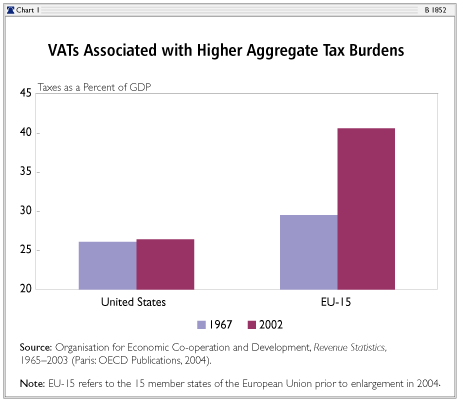
Higher taxes translate into higher spending. As Chart 2 illustrates, government spending in European Union nations consumes a much larger share of economic output. Even if state and local government spending is included, the burden of government spending in the United States is much lower. Interestingly, government debt as a share of gross domestic product (GDP) is also much higher in the EU. This is particularly noteworthy since some incorrectly assert that higher taxes are needed to limit deficits and debt.
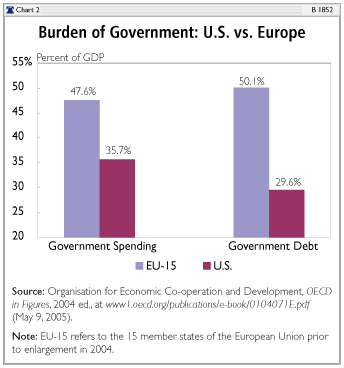
What does this mean for America? With its capacity to generate large amounts of tax revenue, a VAT almost surely would fuel higher government spending. This is precisely what happened in Europe, according to the data. The statistics are echoed in research conducted by the Tax Policy division of the U.S. Chamber of Commerce and published in a 1986 study that examined tax and spending growth between 1965 and 1982. The study found that government spending grew 45 percent faster in VAT nations than in non-VAT countries and that, similarly, the tax burden grew nearly 34 percent faster in VAT countries.[4]
Effect #2: A VAT slows the economy and destroys jobs.
By taking resources out of the productive sector of the economy and transferring them to the government, a VAT would slow economic growth and undermine job creation. The economic damage caused by a VAT is partly due to the increase in the aggregate tax burden.
Additionally, even though it may be less damaging than other forms of taxation, the VAT drives a larger wedge between pre-tax income and post-tax consumption, therefore reducing incentives to engage in productive behavior. As the Congressional Research Service explains:
For households, two out of three major decisions would not be altered by this hypothetical VAT. First, this VAT would not alter choices among goods because all goods would be taxed at the same rate. Thus, relative prices would not change. Second, a VAT would not affect the saving-consumption decision because saving would only be taxed once; that is, when savings are spent on consumption. But the third decision, a household’s work-leisure decision, would be affected by a VAT. Leisure would not be taxed, but the returns from work would be taxed when spent on goods. (In contrast, the income tax affects both the saving-consumption decision and the work-leisure decision.)[5]
The economic damage of a VAT might be avoided if the tax replaced other forms of taxation, but Chart 3 shows that VATs almost always have resulted in a larger aggregate tax burden.
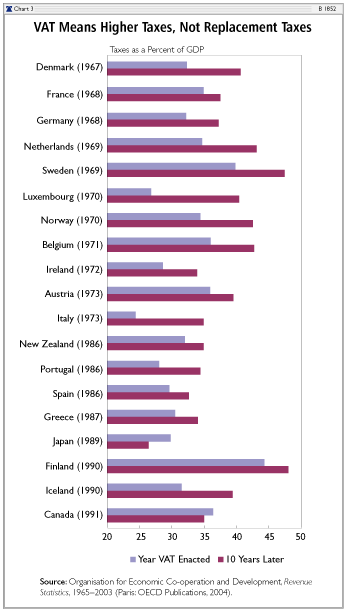
Furthermore, the economic argument against a VAT is not limited to the resulting larger tax burden. The VAT will also negatively affect economic growth because it means more government spending. Scholarly studies have found that there is a strong negative relationship between government spending and economic performance. The following is a very small sampling[6] of the academic literature:
- A study from the Federal Reserve Bank of Dallas noted: “[G]rowth in government stunts general economic growth. Increases in government spending or taxes lead to persistent decreases in the rate of job growth.”[7]
- A study in Public Finance Review reported: “[H]igher total government expenditure, no matter how financed, is associated with a lower growth rate of real per capita gross state product.”[8]
- A study in the European Economic Review reported: “The estimated effects of GEXP [government expenditure variable] are also somewhat larger, implying that an increase in the expenditure ratio by 10 percent of GDP is associated with an annual growth rate that is 0.7–0.8 percentage points lower.”[9]
- A Public Choice study reported: “[A]n increase in GTOT [total government spending] by 10 percentage points would decrease the growth rate of TFP [total factor productivity] by 0.92 percent [per annum]. A commensurate increase of GC [government consumption spending] would lower the TFP growth rate by 1.4 percent [per annum].”[10]
- A Journal of Macroeconomics study discovered: “[T]he coefficient of the additive terms of the government-size variable indicates that a 1% increase in government size decreases the rate of economic growth by 0.143%.”[11]
- A study from the Journal of Monetary Economics stated: “We also find a strong negative effect of the growth of government consumption as a fraction of GDP. The coefficient of –0.32 is highly significant and, taken literally, it implies that a one standard deviation increase in government growth reduces average GDP growth by 0.39 percentage points.”[12]
- A National Bureau of Economic Research paper stated: “[A] 10 percent balanced budget increase in government spending and taxation is predicted to reduce output growth by 1.4 percentage points per annum.”[13]
Without knowing how much government spending in the U.S. would increase after enactment of a VAT or how much of that spending would be in the form of consumption and transfers—the most destructive forms of government outlays—it is impossible to determine precisely how much economic damage a VAT would cause. The impact could be especially severe if a VAT leads to the high levels of government spending found in those countries that currently impose a VAT.
Some economists have estimated the impact of a VAT and found that a VAT would adversely affect U.S. economic performance. According to a 1988 study by Stotler Economics, a Chicago-based economic research firm, a VAT of only 3 percent would, by just the fifth year, reduce the typical family’s income by $1,000 and destroy 2.1 million jobs.[14] The relatively weak performance of many European economies can be attributed, at least in part, to the VAT.
Effect #3: A VAT means higher income taxes.
One of the more interesting theoretical arguments for a VAT is that the new tax would improve economic performance by facilitating a reduction in other taxes. According to some advocates, the additional revenue generated by a VAT—$37 billion for every percentage point, according to the Congressional Research Service[15]—could be used to lower, or perhaps even eliminate, personal and corporate income taxes.
If the VAT was actually used to eliminate all income taxes, this theory would have considerable merit. There is no doubt that personal and corporate income taxes do more damage per dollar raised than a VAT would.
However, no nation has ever implemented a VAT (or a national sales tax) and used the money to eliminate all income taxes. Indeed, no government in the world—national, state, provincial, county, or city—has taken this step. No government has even eliminated just one of the two forms of income taxation (personal and corporate). The VAT always has been imposed in addition to existing personal and corporate income taxes.
Faced with this overwhelming real-world evidence, VAT advocates sometimes argue that the tax at least could be used to lower taxes on personal and corporate income. Just like the total-replacement hypothesis, this partial-replacement hypothesis is an interesting theory, but it is equally implausible. Chart 4 demonstrates that the aggregate tax burden on income and profits (a measure of the tax on personal and corporate income) has fallen slightly in the United States, but it has risen significantly in the European Union, and this increased tax burden on productive activity took place after VATs became ubiquitous.
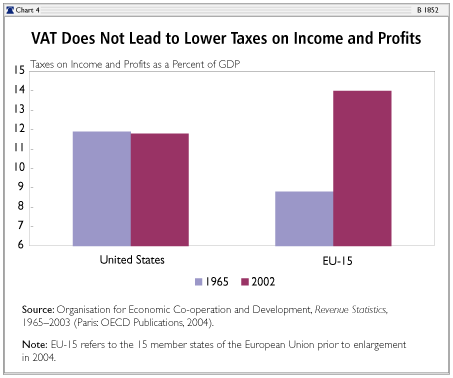
Some members of the business community are seduced by the notion that VAT revenue could be used to lower the corporate tax burden. This is particularly ironic since real-world evidence in Chart 5 shows that the corporate tax burden has climbed in Europe since the VAT was imposed. In the United States, which does not have a VAT, the corporate tax burden has fallen.
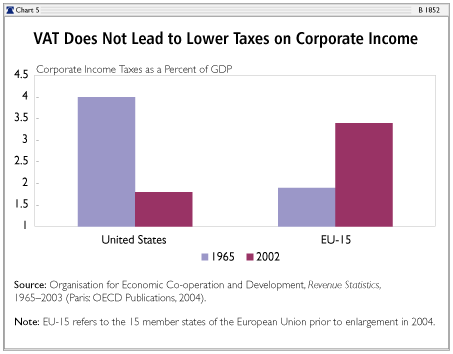
Why is there such a gap between theory and reality? Why are VATs associated with higher income tax burdens rather than lower burdens? The answer almost surely is the politics of class warfare.
In most—if not all—developed nations, there are politicians who are fixated on the distribution of the tax burden. In other words, they want “rich” people to pay a certain percentage of the tax burden. Yet a VAT is evenly distributed among income classes, meaning that the imposition of such a tax would reduce the relative progressivity of the overall tax burden. Certain leftist ideologues oppose this development, and their opposition is often intensified because they mistakenly believe that a VAT is regressive.[16]
Therefore, to obtain political support from the left, politicians seeking to impose a VAT or to increase the rate of an existing VAT often simultaneously increase income tax rates to preserve the progressivity of the entire tax code. There is every reason to think that the same political forces would exist in the United States. For instance, class-warfare rhetoric has been a part of the debate on every proposal to change the income tax, and there is every reason to expect that it would be part of the debate if a VAT was being considered.
Effect #4: A VAT imposes heavy administrative costs on businesses and taxpayers.
A VAT conscripts businesses to serve as tax collectors for the government. This is particularly true if lawmakers impose a credit-invoice VAT, as has been the case in almost every nation that adopts the tax. Under this system, every company and entrepreneur would be forced to keep records on every purchase and submit detailed forms to the government. The administrative burden of the VAT would be especially severe if policymakers chose, as many proponents of the new tax advocate, to exempt certain goods and services. Firms then would have to segregate records according to tax status and submit numerous separate forms to the tax authorities.
The Congressional Budget Office has noted that allowing exemptions would “substantially increase costs of enforcement and compliance.”[17] Specifically:
The value-added tax would require the expansion of the Internal Revenue Service. But the high revenue yield from a VAT could cause administrative costs to be low measured as a percentage of revenue yield. The administrative expense per dollar of VAT collected would vary with the degree of complexity of the VAT, the amount of revenue raised, the national attitude towards tax compliance, and the level of the small business exemption.… In 1984, officials at the U.S. Treasury estimated that a completely phased in VAT would require additional staff of 20,694 at a cost of $700 million or approximately $1 billion at 1991 salary levels.[18]
Compliance costs would also rise if politicians chose to apply different rates to different goods and services. Most nations with VATs not only exempt certain products altogether, but also tax certain goods and services at different rates.[19] Depending on the country, the VAT rates differ for non-alcoholic drinks, candy, sugar, consumer electronics, clocks and watches, furs, jewelry, playing cards, cigarette lighters, matches, toiletries, drugs and medicines, books and newspapers, insurance, telephone service, advertising, entertainment, hotels, and restaurants. Some nations have as many as six separate rates of taxation.[20]
Thus, even though VAT advocates use theoretical models to assert that the tax is cheap to administer, the real-world evidence suggests otherwise. The Congressional Budget Office estimated in 1992 that the costs to the government would total as much as $1.5 billion and that the private sector would face an additional burden of as much as $7 billion.[21]
The VAT would be especially painful for small businesses—the segment of the economy that generates most new jobs. Unlike larger firms, which generally have legal and accounting divisions that could be used to keep compliance costs relatively low, small businesses without such in-house expertise would face disproportionately high costs, totaling as much as 2 percent of sales.[22] In Canada, which adopted a VAT in 1991, the complexity of the levy was estimated to have driven one-fourth of small businesses into the underground economy.[23]
Selected VAT Myths
In their campaign to impose a new tax on American consumers, VAT proponents claim that the tax would have several desirable effects. In most cases, these claims are wrong or grossly inaccurate. In other instances, the claim may be true, but the result is not desirable. For instance:
Assertion #1: A VAT would increase savings by reducing the over-taxation of savings and investment.
Reality: Raising taxes on consumption does not solve the problem of excessive taxation of savings and investment.
Taking more money out of consumers’ pockets, as a VAT clearly would do, necessarily would result in less total private savings in the economy. Indeed, a cross-country study of 23 nations in Business Economics found that “savings rates are not higher in countries that rely more heavily on a VAT for revenue.”[24]
Whenever taxes are raised, even if consumption is being taxed, the effect is to lower individual savings because patterns of consumer spending are unlikely to change quickly. Therefore, a VAT would actually exacerbate the tax code’s negative effect on savings. Moreover, since imposition of a VAT would reduce economic growth, the incentives to invest would be lower than they would be without a VAT.
Many VAT proponents admit that if a VAT were added to existing taxes, it would reduce total savings, but they then argue that the tax revenues could be used to lower or eliminate other taxes that have more damaging effects on savings and investment. While this is fine in theory, the evidence from Europe indicates that this simply does not happen. As discussed above, countries with VATs tax income at higher rates than do countries without VATs. In other words, the tax is added to other taxes. It is not a substitute for them.
Assertion #2: America is one of the few industrialized nations without a VAT.
Reality: Fortunately, this assertion is true. America is the only developed nation without a VAT.
Many VAT proponents imply that this means that America is somehow backward. Yet the absence of a VAT helps to explain why the burden of government is lower in America and why U.S. economic output is so much higher. The notion that America should mimic the tax policies of European nations is especially bizarre given that the European Union is mired in economic stagnation. For instance:
- Per capita economic output in the U.S. in 2003 was $37,600—more than 40 percent higher than the $26,600 average for EU-15 nations.[25]
- Real economic growth in the U.S. over the past 10 years has been more than 50 percent faster than EU-15 growth over the same period—3.2 percent average growth compared to 2.1 percent average growth. The gap has become even larger since the Lisbon Strategy was announced.[26]
- The U.S. unemployment rate is significantly lower than the EU-15 unemployment rate, and there is a stunning gap in the percentage of unemployed who have been without a job for more than 12 months—11.8 percent in the U.S. versus 41.9 percent in EU-15 nations.[27]
- Living standards in the EU are equivalent to the living standards in the very poorest American states—roughly equal to the living standards in Arkansas and Montana and only slightly ahead of the living standards in the two poorest states, West Virginia and Mississippi.[28]
Assertion #3: A VAT would make American products more competitive in world markets.
Reality: A VAT would have no effect on the balance of trade.
Since a VAT is rebated on exports and imposed on imports, some believe that the tax would help sell more American-made products. This is not true. Adding a VAT to imports means that consumers would have to pay more, regardless of where the product originated. For instance, a 5 percent VAT would not change the relative costs of a Nissan Maxima and Ford Taurus. All that would happen is that they would both be 5 percent more expensive thanks to the tax.[29]
Similarly, even though a VAT is rebated on exports, if the country importing the product has a VAT, the American export will be subject to the levy just as foreign goods would be treated in America. If the other country does not have a VAT, American exports still would not gain a competitive advantage since both the American products and the host country products would be free of the tax.
VAT supporters point out that most other taxes, particularly income taxes and payroll taxes, are not rebated on exported goods and that this policy makes American products more costly and less competitive. While this is true, adopting a VAT will not solve the problem. The only way to address the damaging impact of income and production taxes is to reduce them.
Perhaps the easiest way to understand why a VAT will not alter trade balances is to look at aggregate trade and capital flow data. A trade deficit is always accompanied by a capital surplus. This is a widely recognized and uncontroversial accounting identity. By claiming that a VAT will reduce the trade deficit, proponents are really arguing that a VAT will reduce the flow of foreign capital to the U.S. economy. Yet what is the basis for thinking that a VAT would alter international capital flows? The Congressional Research Service explains:
With flexible exchange rates, the supply and demand for different currencies determine their relative value. If a country has a deficit in its balance-of-trade, this deficit must be financed by a net import-ation of foreign capital. But net capital inflows cannot continue indefinitely. Thus, over time, this country’s currency will tend to decline in value relative to the currencies of other nations. Consequently, this country’s balance-of-trade deficit will eventually decline as its exports rise and imports fall. Hence, economic theory indicated that a VAT offers no advantage over other major taxes in reducing a deficit in the balance-of-trade.[30]
Assertion #4: A VAT could generate substantial new revenue for the federal government.
Reality: The assertion is true, but this is precisely why a VAT is not desirable.
Assertion #5: Taxes on consumption do less damage to the economy than taxes on income and production.
Reality: The assertion is true, but simply because a VAT is less damaging than certain other taxes hardly qualifies as a reason to impose the tax.
This argument would be relevant only if policymakers were considering wholesale elimination of income taxes and seeking an alternative source of revenue.[31] However, since politicians generally view the VAT as an additional source of revenue, adoption of the tax would simply compound the damage caused by the current tax code.
It is also worth noting that no country with a VAT has ever used the tax to eliminate taxes on income, profits, or production. Indeed, as noted earlier, the tax burden on productive economic activity is higher in countries with VATs.
Assertion #6: A VAT is a simple tax with low compliance costs.
Reality: This assertion is theoretically true, but contradicted by real-world evidence.
If a VAT is kept free of special preferences, administration costs will be low, at least compared to the income tax. However, based on Europe’s experience, this hope may be unrealistic.
Many VATs either exclude or grant preferential rates for such items as food, housing, and medical care. This reduces the tax burden on consumers buying these items, but such exemptions add to the accounting complexity and costs for businesses. More important, preferential tax rates are a form of backdoor industrial policy that distorts the allocation of resources and thus hinders economic growth, in addition to which special preferences for some items presumably mean pressure for higher tax rates elsewhere.
Conclusion
Enacting a value-added tax would be a costly mistake for American consumers and workers. Once adopted, the VAT would prove irresistible to politicians eagerly looking for money to pay for new programs. The VAT would also undermine entitlement reform because politicians could gradually increase the tax to finance promised benefits.
The tax rate would doubtlessly climb, financing a surge of new federal spending. The result would be a stagnating economy, higher budget deficits, and fewer jobs for American workers. The value-added tax may have some attractive theoretical qualities compared to taxes on income and production, but in the real world, it would simply be another burden on an already overtaxed economy.
Daniel J. Mitchell, Ph.D., is McKenna Senior Research Fellow in the Thomas A. Roe Institute for Economic Policy Studies at The Heritage Foundation.


